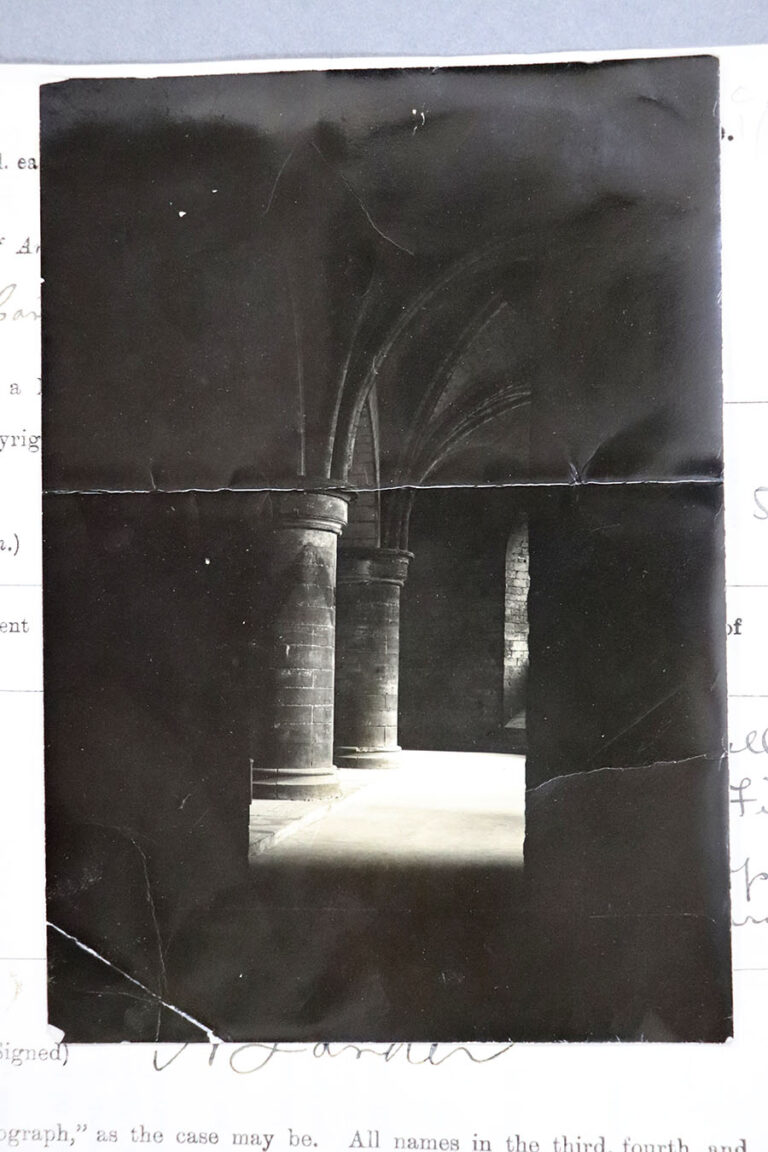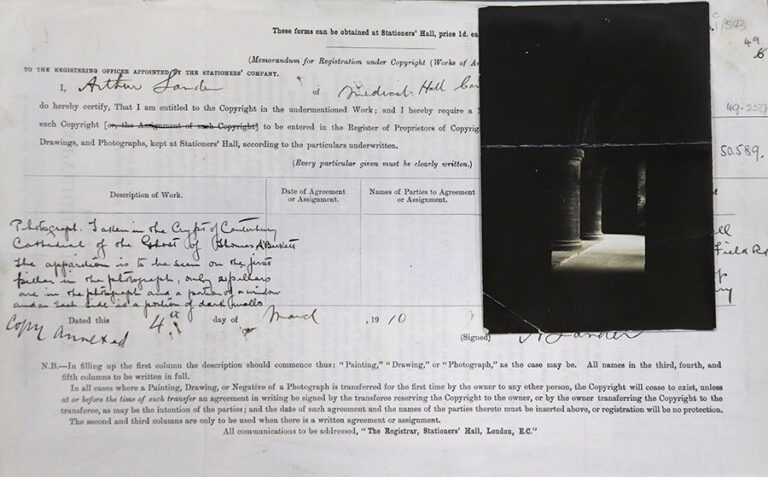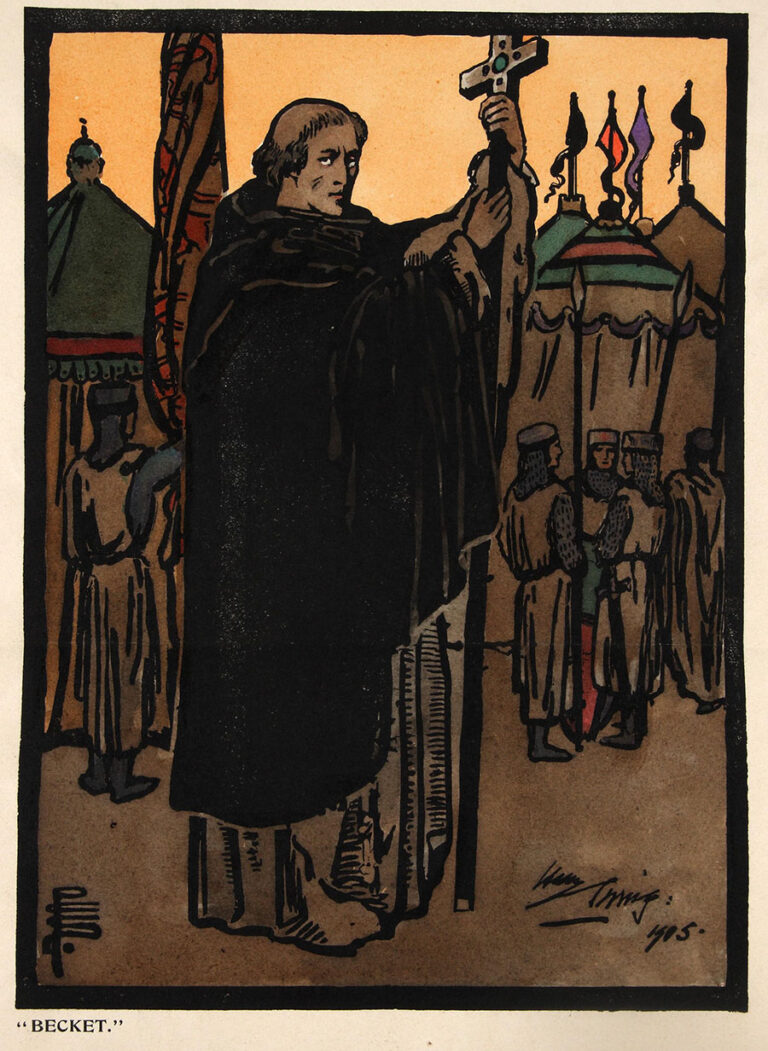Everyone loves a ghost story at Christmas, right? One might even say they represent the true spirit of the season … (sorry!). But when the ‘ghost’ is one of the most famous men in English history, that takes on another dimension altogether.
Ladies and gentlemen, I present to you the ghostly apparition of St Thomas Becket, the 850th anniversary of whose brutal murder and martyrdom in Canterbury Cathedral on 29 December 1170 we commemorate today. Quite frankly, though, if you can spot the great man here you have sharper eyes than I do.

This curious photographic image is filed among the vast archive of original forms submitted by applicants wishing to register their authorship and/or ownership of copyright in literary and artistic works between 1842 and 1912. Formerly held by the Copyright Office at Stationers’ Hall, London, these forms are now at The National Archives in COPY 1, a series which has benefited from some significant new cataloguing in recent years, as my colleague Katherine Howells outlines in her blog from June. Registered on 4 March 1910, the image is described as:
‘Photograph taken in the crypt of Canterbury Cathedral of the ghost of Thomas A’ Becket. The apparition is to be seen on the first pillar in the photograph. Only two pillars are in the photograph and a portion of a window, and on each side is a portion of dark walls.’

Thomas Becket, the archbishop who stood up to royal tyranny and paid with his life, has long held an important place in popular imagination. The sites of his martyrdom in Canterbury Cathedral quickly attracted pilgrims, a trend which continues today – a recent research project led by the Centre for Christianity and Culture at the University of York has digitally reconstructed his shrine.
Becket’s medieval cult spawned pilgrim badges, works of literature and devotion, and the dedication of monastic houses, parish churches and chapels across the British and Irish Isles. In more modern times, Becket has been the subject of T S Eliot’s verse drama Murder in the Cathedral and Alfred Lord Tennyson’s Becket, for the latter of which Pamela Colman Smith registered the copyright for this artwork of the famed Victorian actor Henry Irving as the saint for its national tour of 1905, a tour on which Irving would die after a performance in Bradford.

The archbishop saint will also be the subject of a major exhibition at the British Museum, now rescheduled for April 2021. In Canterbury itself, Becket has long been a draw for tourists, his image being employed, for example, by Southern Railway in its publicity campaigns. We might suspect, therefore, that the appearance of his ‘ghost’ in Canterbury Cathedral contributed to the marketing of the Edwardian city as more than just a pilgrimage destination. Perhaps though, there is more here than meets the eye.
The ownership of copyright to the image was registered by one Arthur Lander, for which he paid a fee of one shilling as per the 1862 Fine Arts Copyright Act.

A pharmacist and optician, Lander operated his business from and resided at The Medical Hall at 17 High Street, Canterbury, which he had acquired with his partner J T Smith in 1899 1. Census returns from 1901 and 1911 tell us that Lander was the son of a farmer and miller from the parish of St Keyne, near Liskeard in north Cornwall, and that he had trained as an assistant chemist to Frederick Tunbridge in Reading. He settled in Canterbury with his first wife Hannah Smith from County Durham, with whom he had two children, and then, after her death in 1907, with Elizabeth (Bessie), from Christow in Devon, mother to a third child 2. Within a decade the Medical Hall had been transformed into a thriving business with domestic apartments and photographic studios over three storeys. The property was valued at £3,240 gross in this scrawled assessment for the 1910 Finance Act.

Lander appears to have become a prominent local photographer, operating from Cooper Art Studios in the Medical Hall. Several other registrations of copyright in images within the COPY 1 series show him specialising in portraiture. Local worthies, such as the legendary Kent and England cricketer Frank Woolley, and the Conservative MP for Canterbury from 1892-1910 John Henniker Heaton and his Liberal opponent in 1910 Drysdale Woodcock, sought the golden light of his lens.
Such portraits in postcard form had commercial and (in the politicians’ cases) political publicity value for the sitters and the cameraman. Lander’s local reputation was such that in 1909 he was an invitee to the 24th Annual Meeting of the Photographic Convention of the United Kingdom, held in Canterbury.
However, despite also being a keen naturalist, scientific instrument maker and astronomer, Lander also either dabbled in the supernatural or, as appears more likely, used it as a forum for photographic experimentation 3.
The Becket image is not the only photograph he registered for copyright protection in the 1900s which has a supernatural bent. In ‘The Hereafter’ we have a lady looking into the distance, dressed in dark clothing with one hand on a skull, reflecting perhaps the transient nature of human existence.
Lander, however, also produced commercially several ‘spirit photographs’, images of which are accessible on the Historic Canterbury website. They all show a sitter facing the camera with a ghostly face of, what one must assume, a loved-one hovering over one shoulder, or a wispy vapour cloud enveloping the sitter.
Lander’s spirit images placed him, even in 1910, in an established tradition of photographers who used advances in camera technology to play on the margins of science and spirituality. The late-Victorian and Edwardian eras witnessed a boom in both spiritualism and spirit photography, a trend initially patronised by Queen Victoria and Prince Albert.
There are several ways in which these ghostly images can be produced, most obviously using a long exposure and movement of the subjects during exposure, or double exposure. The latter involved inserting a previously prepared positive glass plate with an image of the ‘deceased’ in front of the sensitive unexposed glass plate for capturing the sitter. The resulting image would then superimpose the live sitter over a background in which the ‘deceased’ would appear from the ether.
While there have been noted charlatans, using these techniques for personal gain at the expense of the vulnerable or gullible, for many the production of such images came from a desire to experiment and stretch technological boundaries as much as for commercial gain (though stereocards were sold bearing ghost photographs from the late 1850s) 4. Nonetheless, the capture of an image of the saintly archbishop must surely have had commercial and reputational imperatives, locally, regionally and perhaps nationally, for Arthur Lander.
The registration of copyright ownership meant that Lander possessed exclusive rights to copy the image and otherwise reproduce it in multiple from the negative by any means or at any size for life and seven years thereafter. In his case that would have been 1954, as he died aged 75 in Canterbury in the summer of 1947 5.
To what ends Lander put the image is uncertain. His subsequent employment as a local Justice of the Peace and exhibitor of lantern slide images of astronomical phenomena, such as sunspots for the British Astronomical Association, suggests a respectable local citizen of whom no malice or fraud was suspected in his production of spirit images.
We can, I think, imagine the Becket photograph becoming an object of real fascination for tourists who flooded into Canterbury in the years before the First World War, an interesting keepsake from their visit to what has now become a World Heritage Site.
The image also speaks to the star power of Thomas Becket at the end of an era where the medieval had experienced a significant revival in popular culture. In this, the ninth centenary year of his birth, the 850th anniversary year of his martyrdom and the eighth centenary year of the translation of his body to a new shrine in Canterbury, we can only expect the popular fascination with Becket to revive once more.
Notes:
- The inspiration for this blog – and the source of some of the local information – is the Historic Canterbury website: http://www.machadoink.com/Arthur%20Lander.htm ↩
- RG 13/794, f. 54 (1901); RG 14/4341, schedule 108 (1911) ↩
- Lander was Honorary Secretary of the East Kent Scientific and Natural History Society at the turn of the 20th century: http://www.machadoink.com/Arthur%20Lander.htm ↩
- For which see Howard Timberlake, ‘The Intriguing History of Ghost Photography’, BBC Future, 30 June 2015: https://www.bbc.com/future/article/20150629-the-intriguing-history-of-ghost-photography; Colin Harding, ‘G is for … Ghosts: the Birth and Rise of Spirit Photography’, Science Museum Blog: https://blog.scienceandmediamuseum.org.uk/photography-a-z-ghosts-spirit-photography/ ↩
- https://www.freebmd.org.uk/cgi/information.pl?r=194801692:1620&d=bmd_1605601217 ↩

He’s on the pillar!
Oh no he’s not..!
Sorry, I couldn’t resist it, although there does appear to be an icon-like image on the pillar to the left of the frame.
The image on the pillar is visible today, as in it really exists.
Hi!
Yes it does exist. I have a photo of me looking up at the image on the pillar circa 1968.
I was in the cathedral yesterday (Aug 2022) and saw the exact image. We were told not to take photos here so I didn’t. It is 100% a pattern in the pillar! I should add I do believe in spirits etc but this wasn’t one. It took me by surprise when I saw it because it looked like a monk but it is a at term in the pillow.
In the Crypt there are a number of sratched figures, possibly for wall paintings. Much later the Crypt was used as a coal store for the Canons!
40 years ago when l started guiding in the Cathedral we pointed out the ghostly shadow to visitors!!
Morale, never believe a tour guide!!
When I was 12 on a school trip to Canterbury cathedral we was shown to where Thomas a Becker was murdered, myself and one girl saw his ghost quite clearly, but the rest of the party just thought we were weird, because they could not, that was 61 years ago & still clear im my memory,